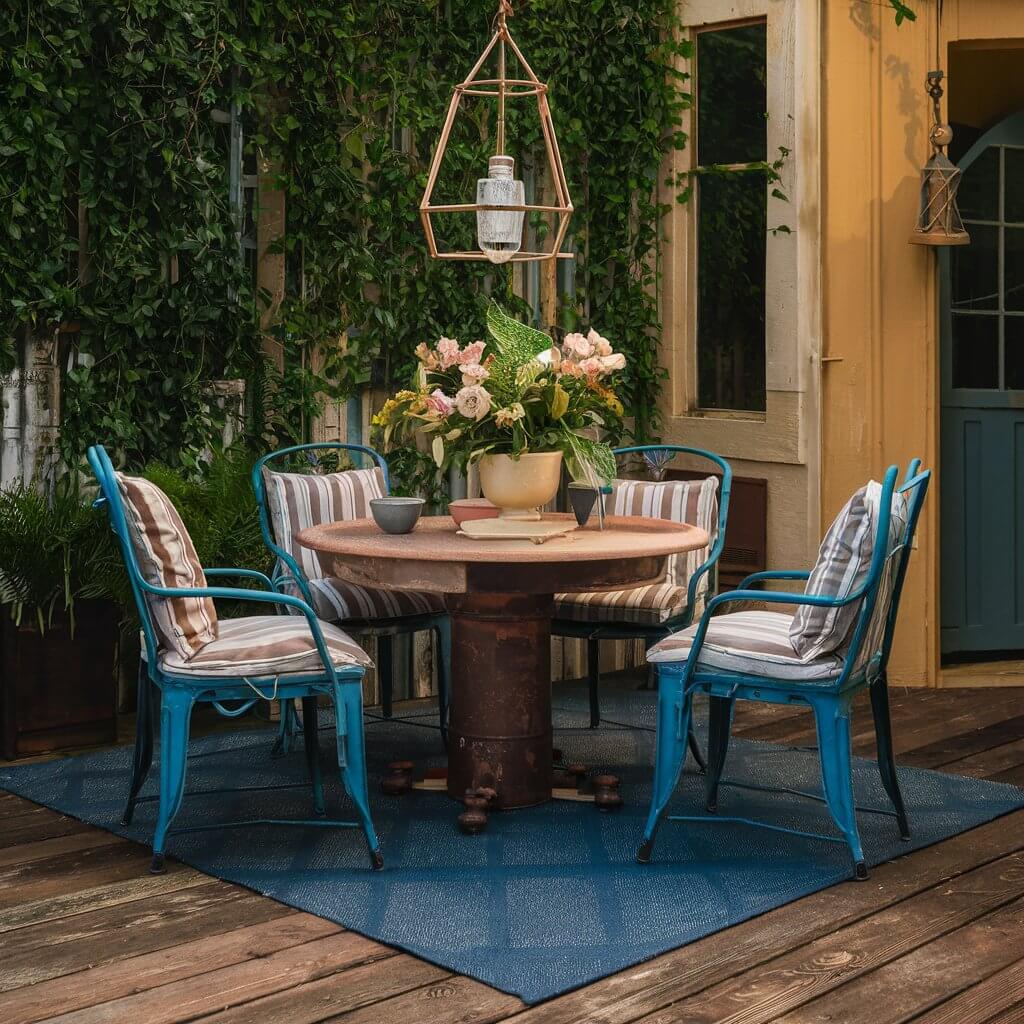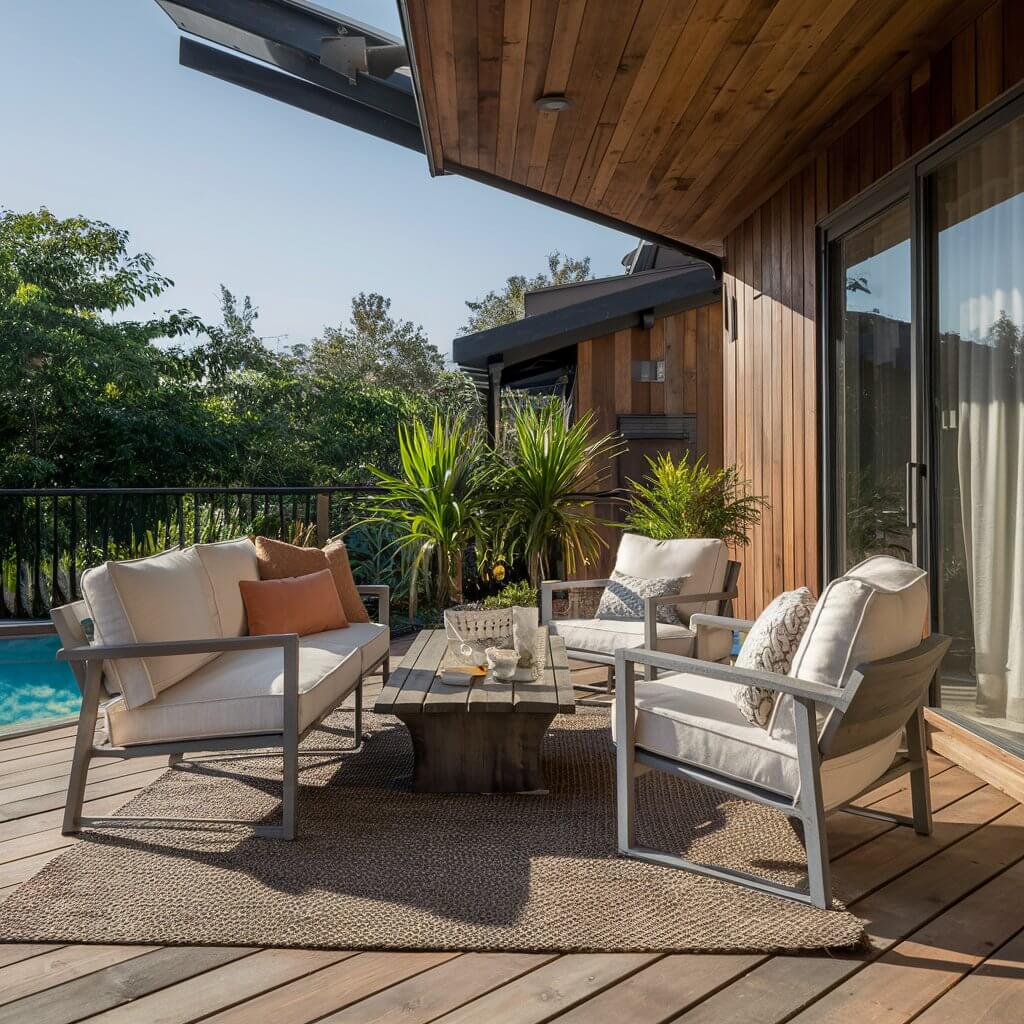Outdoor Furniture Restoration is a cost-effective way to revive your patio or garden pieces, giving them a fresh, new look without breaking the bank.
Whether your outdoor chairs are weathered, your table is rusted, or the cushions have seen better days, restoration can bring them back to life.
Not only does it enhance your outdoor space, but it also helps you maintain quality furniture for years to come. Discover expert tips and tricks for restoring outdoor furniture like a pro.
10 Inspiring Outdoor Furniture Restoration Ideas to Refresh Your Space
1. Power Wash and Refinish Wooden Furniture

Start with a thorough power wash to remove dirt, grime, and mildew from your wooden furniture.
After it dries completely, sand the surfaces with 150-220 grit sandpaper to smooth out any rough patches and prepare for refinishing.
Choose a high-quality outdoor wood stain that complements your space; consider colors like walnut or teak for a rich finish.
Apply the stain using a rag for an even coat, followed by a protective sealant to safeguard against moisture and UV rays. This process not only refreshes the look but also extends the life of your wooden pieces.
2. Transform with Bold Paint Colors

Painting is one of the simplest ways to give old furniture a fresh look.
Choose vibrant outdoor-safe paint in colors that reflect your personality—think sunny yellows or ocean blues. Before painting, clean the furniture thoroughly and lightly sand the surfaces to help the paint adhere better.
Apply a primer first, especially if you’re changing from a dark to a light color, followed by at least two coats of paint. This transformation can turn drab furniture into eye-catching focal points in your outdoor area.
3. Upholster Cushions for Comfort and Style

Old cushions can make even the best furniture look tired. Consider reupholstering them with weather-resistant fabric that matches your decor style.
Remove the old fabric and padding, then cut new pieces to size, securing them with a staple gun.
Opt for bold patterns or bright colors to add flair. If you prefer a simpler approach, just replace the cushion covers with new ones; this can significantly refresh your seating without a complete overhaul.
4. Create a Rustic Look with Distressing Techniques

For those who love a vintage or rustic aesthetic, distressing your outdoor furniture can add character and charm.
Start by sanding down certain areas to create worn spots, then apply a base coat of paint followed by a contrasting top coat.
Once dry, lightly sand again to reveal some of the base color underneath. Finish off with a clear sealant to protect your newly distressed pieces while maintaining their unique appearance.
5. Add Decorative Stencils or Patterns

Stenciling is an excellent way to personalize your outdoor furniture without needing advanced skills.
Choose stencils that reflect nature—like leaves or geometric patterns—and use outdoor-safe paint to apply them onto tables or chairs.
This technique can transform plain surfaces into artistic statements that enhance your overall decor theme while keeping it cohesive and stylish.
6. Revive Metal Furniture with Rust Treatment

Metal outdoor furniture can suffer from rust and wear over time.
Start by using a wire brush or orbital sander to remove rust spots thoroughly. Follow up with a rust-inhibiting primer before applying two coats of high-quality outdoor paint in your desired color.
This not only restores functionality but also protects against future corrosion, ensuring your metal pieces remain beautiful and durable for years.
7. Incorporate Natural Elements with Wood Accents

If you have plastic or resin furniture, consider adding wooden accents for warmth and texture. You can create wooden tabletops or armrests using reclaimed wood for an eco-friendly touch.
Simply cut the wood to fit, sand it down, and attach securely using screws or adhesive suitable for outdoor use.
This combination of materials creates an inviting contrast that enhances both comfort and aesthetics.
8. Use Fabric Paint for Unique Designs

If you’re feeling creative, fabric paint can be used on old cushions or even directly on fabric-covered furniture pieces.
Sketch out designs—floral motifs or abstract patterns—and apply fabric paint accordingly.
This DIY approach allows you to customize your furniture entirely while giving it a fresh look that reflects your style.
9. Create an Outdoor Bar Cart from Old Furniture

Repurpose an old side table or cart into an outdoor bar station for entertaining guests. Sand down any rough areas and repaint it in vibrant colors that match your patio decor.
Add hooks on the sides for towels and hang glasses from the bottom shelf.
This functional transformation not only gives new life to old furniture but also enhances your outdoor gatherings.
10. Mix and Match Styles for Eclectic Charm

Don’t shy away from mixing different styles of furniture! Combine modern pieces with vintage finds for an eclectic look that feels curated over time rather than bought all at once.
Use similar color palettes across different items to maintain cohesion while allowing each piece’s unique character to shine through—this approach creates an inviting atmosphere full of personality.
By implementing these restoration ideas, you can transform tired outdoor furniture into stunning focal points that enhance both functionality and beauty in your outdoor spaces!
5 Incredible Benefits of Restoring Your Outdoor Furniture
- Cost-Effective: Restoring outdoor furniture is much cheaper than buying new pieces, helping you save money.
- Eco-Friendly: By restoring, you reduce waste and contribute to environmental sustainability.
- Customization: You can refresh old furniture with new colors or finishes to match your evolving style.
- Durability: Proper restoration improves the longevity and strength of your outdoor furniture.
- Sentimental Value: Restoring keeps cherished pieces in use, preserving their personal or historical significance.
How do you fix broken plastic patio chairs?
Fixing broken plastic patio chairs can be a straightforward process that restores their functionality and appearance. Start by identifying the type of damage. For minor cracks, use a plastic adhesive designed for outdoor use.
Clean the broken edges thoroughly to ensure a strong bond, then apply the adhesive and hold the pieces together for a few minutes until set. For larger breaks or missing pieces, consider using a two-part epoxy.
Mix the epoxy as per the manufacturer’s instructions, apply it to the broken areas, and clamp them together until fully cured.
If the chair is structurally compromised, reinforce it with metal brackets or L-brackets. Attach these brackets to the underside of the chair using screws, providing additional support. For aesthetic purposes, touch up the repaired areas with plastic paint that matches the original color.
Lastly, to prevent future damage, store the chairs in a shaded area when not in use, as prolonged exposure to sunlight can weaken the plastic.
Regular maintenance checks can help identify and address issues before they escalate, extending the lifespan of the chairs.
What is the best way to waterproof outdoor furniture after restoration?
The best way to waterproof outdoor furniture after restoration involves a few critical steps to ensure long-lasting protection.
Start by thoroughly cleaning the furniture, removing any dirt, dust, or remnants from the restoration process. Once dry, apply a high-quality wood sealer, specifically designed for outdoor use.
This will create a protective barrier against moisture. For added durability, use a water-repellent finish or exterior varnish over the sealer, focusing on joints and crevices where water tends to accumulate.
For metal furniture, opt for a rust-inhibiting primer followed by a weather-resistant paint or a specialized outdoor metal coating. For wicker or synthetic materials, applying a UV-resistant spray can prevent sun damage and keep moisture at bay.
Always allow each coat to fully dry before applying the next, ensuring a thorough waterproofing process. Regular maintenance, such as reapplying protective coatings every season, will also help preserve the furniture’s condition and keep it safe from the elements.
How do you remove mildew and mold from outdoor furniture?
To effectively remove mildew and mold from outdoor furniture, start by mixing a cleaning solution of one cup of white vinegar with a gallon of water.
Apply this solution to the affected areas using a sponge or a soft-bristle brush. Gently scrub the furniture, ensuring the solution penetrates any crevices where mold and mildew tend to grow.
After scrubbing, rinse the furniture thoroughly with clean water to remove any residue. For tougher spots, add a few drops of dish soap to the mixture or opt for a mild bleach solution—only if the furniture material allows it.
Once cleaned, allow the furniture to dry completely in the sun, as direct sunlight helps kill any remaining spores.
To prevent future growth, consider applying a protective sealant to porous surfaces or regularly cleaning and storing furniture in a dry, well-ventilated area when not in use.
Consistent maintenance will keep outdoor furniture looking fresh and mold-free throughout the season.
What type of sealant is best for protecting restored outdoor furniture?
For protecting restored outdoor furniture, the best type of sealant largely depends on the material of the furniture and the environment it will be exposed to. For wood furniture, a marine-grade polyurethane or spar varnish is highly recommended.
These sealants offer strong protection against UV rays, moisture, and temperature fluctuations, ensuring longevity in outdoor conditions. If the furniture is metal, a rust-inhibiting clear coat or enamel sealant works best to prevent corrosion and weathering.
For wicker or rattan furniture, a clear outdoor polyurethane or lacquer spray will provide a durable shield while maintaining the natural texture of the material.
For plastic furniture, a UV-resistant acrylic sealant is ideal to prevent fading and cracking from prolonged sun exposure.
In all cases, applying multiple thin layers of the sealant and allowing proper drying time between coats is essential for optimal protection.
With the right sealant, outdoor furniture will stay protected from the elements, ensuring it looks fresh and well-maintained for years.
